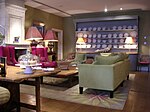BT Archives
AC with 0 elementsArchives in the London Borough of CamdenBT GroupBusiness and industry archivesHistory of telecommunications in the United Kingdom ... and 3 more
Online archives of the United KingdomOrganisations based in the London Borough of CamdenPhoto archives in the United Kingdom

The BT Archives is an archive preserving the documentary heritage of the British telecoms company BT and its public sector predecessors. It is designated an official place of deposit for Public Records, for those records created prior to BT's privatisation in 1984. The records include minutes, subject files, photographs, film and advertising material that tell the story of telecommunications in the UK and from the UK to overseas, from the formation of the private telegraph and telephone companies in the nineteenth century to the present day.
Excerpt from the Wikipedia article BT Archives (License: CC BY-SA 3.0, Authors, Images).BT Archives
High Holborn, London Holborn (London Borough of Camden)
Geographical coordinates (GPS) Address Nearby Places Show on map
Geographical coordinates (GPS)
| Latitude | Longitude |
|---|---|
| N 51.518 ° | E -0.1165 ° |
Address
University of the Arts London
High Holborn 272
WC1V 6LS London, Holborn (London Borough of Camden)
England, United Kingdom
Open on Google Maps










